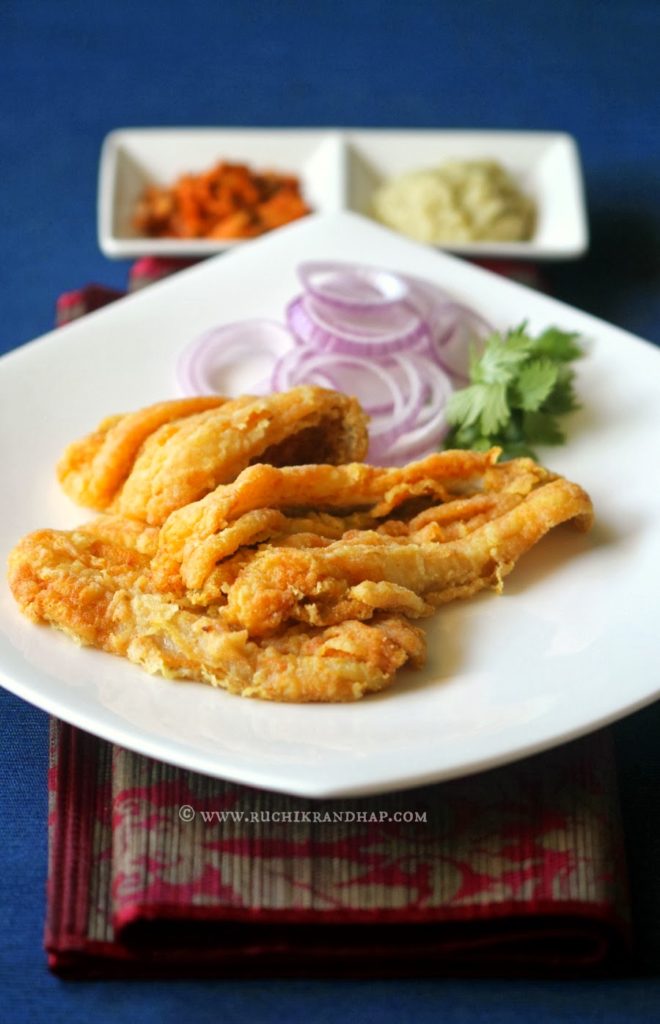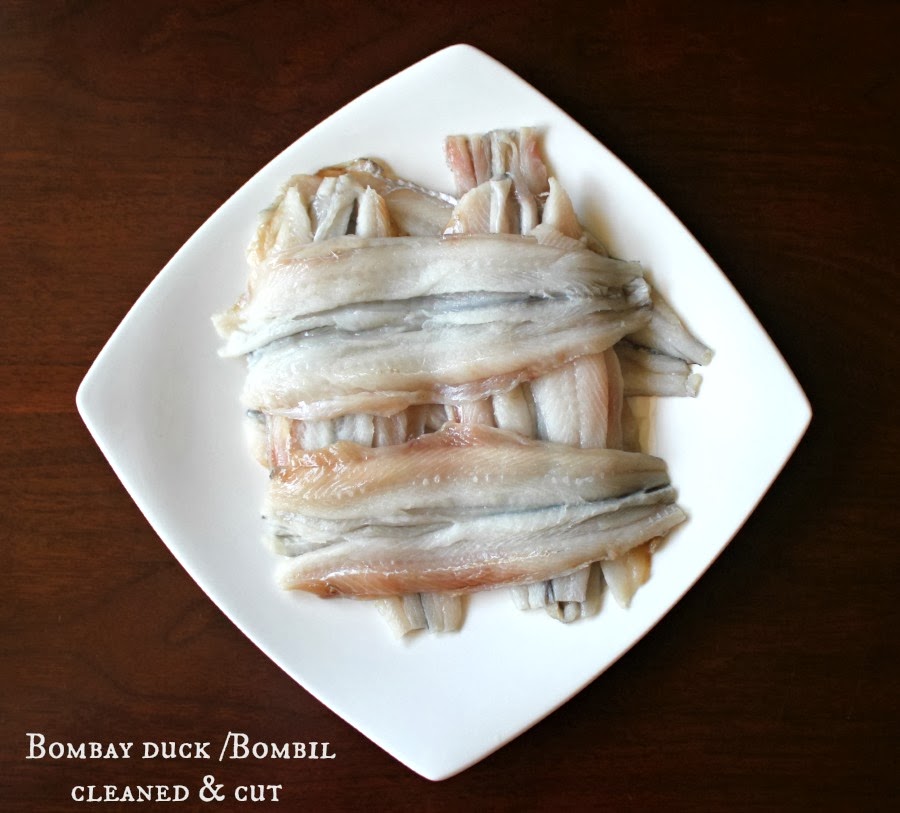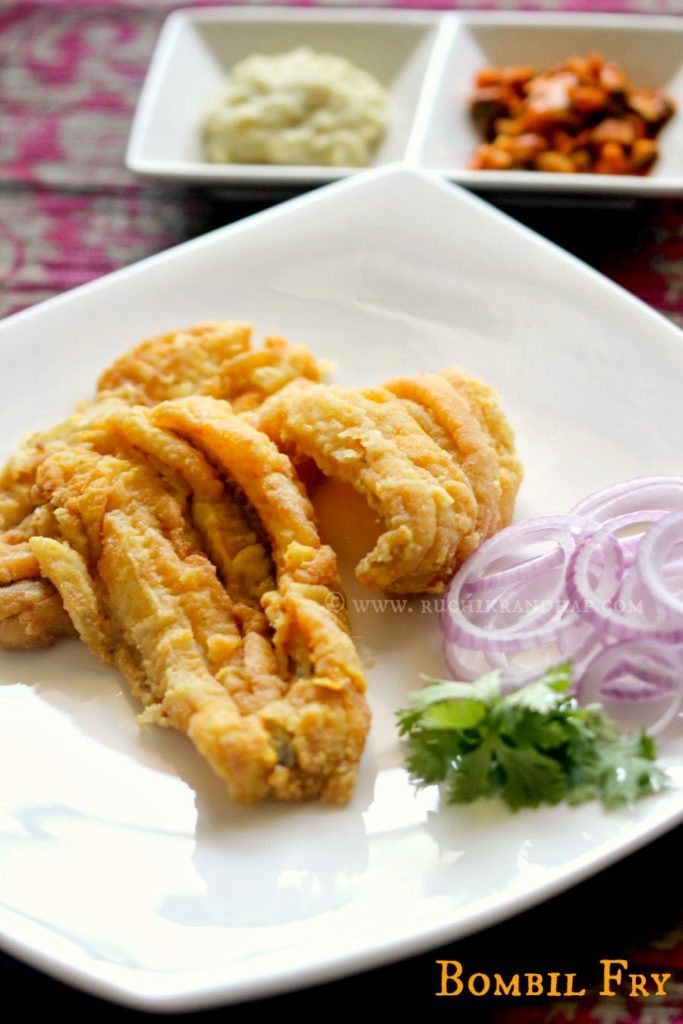Despite its name, the Bombay Duck is not a duck! It is a variety of fish that is found in the Arabian sea especially on the coast of Mumbai and Kutch (in Gujarat). Bombay duck is pretty popular in Mumbai (it has to be!) and is eaten both fresh and in its dried form (salted fish). There two forms of consuming this lovely fish are distinctly different from each other because of the way it smells. While the fresh fish has no odour (apart from a mildly fishy smell inherent to any seafood) or any distinctive taste (just a delicate flavour that takes any kind of marination well) the dried form is well, loved by some and hated by the rest. Although I love seafood of any sort (except for those which I am allergic to) I have a particular aversion to the dried Bombay duck as it smells like crazy! My friend in Mumbai once sent me a small portion of salted Bombay duck which she had prepared. It was her favourite she said.
I never fathomed how terribly nauseous I would feel when the stink (or aroma if you please!) wafted towards my house from the lift/elevator area! Gosh! One look at it and into the bin it went. Sorry to those who just gasped that I wasted good food. In my defence, I normally never throw food away no matter how it tastes. But if it smells bad there’s no way in hell I am going to eat it man! Ok, now that I sound sufficiently arrogant, let me continue with the etymology of the this fish!
Nobody knows the real reason behind its name. Why is it called the ‘Bombay duck’? A bit of Googling brought me to this answer on Wikipedia which I quite liked and will go with until someone throws some more light on it. Apparently the shoals (groups) of fish around the Eurasian continent (combined landmass of Europe and Asia) were separated when the Indian plate moved into it (in short, parts of the land on planet Earth moved some donkey’s years ago, like a million years ago and the current map of the world is what we see as a result of this). So basically the waters surrounding the Eurasian continent were divided by the land that is now called as India. The species of this fish was thus divided into what remained on the Western coast of India (around Mumbai and Kutch) and a small part of this fish can be found in eastern Bengal.
During the British Raj when the railways were formed, people in eastern Bengal were made aware of the great availability of the locally prized fish on India’s western coast and hence they began importing them by the railways. When the dried fish was being transported by the railways its overpowering smell compelled them to later transport the consignment via the mail train, the Bombay Mail (or Bombay Daak). ‘Daak’ is the Hindi word for ‘mail’. The Bombay Mail that reeked of the fish smell thus helped coin the popular term ‘You smell like the Bombay Daak’. ‘Bombay Daak’ was eventually corrupted to ‘Bombay duck’. Anyway, this theory is not supported by the Oxford English Dictionary which mentions the term ‘Bombay duck’ two years before the first railroad in Bombay was constructed. As per local Bangladeshi stories, the term Bombay duck was coined by Robert Clive who tasted this fish during his conquest of Bengal and associated its pungent smell with that of the newspapers and mail that would come into the cantonments from Bombay. If you ask me, I liked the first theory better than this, but since nobody really knows, lets just leave the name and move ahead with how the fish tastes. What’s in a name after all eh?
During my initial years in Mumbai I never had the courage to buy the fish from my fish market, especially because it looked too soft and wobbly when fresh and too stinky when dried. Moreover, we didn’t know how it was to be cleaned, although the fisher women would have gladly although improperly cleaned the fish for a few extra bucks. We always considered buying it and gave it a pass and settled for other types of fish. However, we eventually tried the deep fried version of this fish – simply marinated and coated with something that made the fish so ultra crispy and firm that Roshan and I fell in love with it. We would particularly order it at the Pebbles restaurant on Andheri Link road (they have another restaurant opposite the Mariott Hotel, Juhu) and this dish would always be the highlight of the evening, especially if we had out of towners visiting us, we made sure they got a taste of the Bombay duck!
Roshan was hell bent on trying it out at home and eventually we bought it a couple of times before we left Mumbai. The fisher woman did clean it for us and all we had to do is marinate it, coat it with batter and deep fry it. The first couple of attempts failed so we brought our passion to Dubai, hunted the fish down in the Diera fish market and set to work. A couple of attempts is all it took to perfect it. If you wish to taste it before trying it out at home, you can find it on the menu in the Gajalee restaurant at the Circuit House, one of our usual haunts whenever we visit Mangalore. In Mumbai, Pebbles restaurant is excellent for all kinds of Mangalorean and Malvani fare especially seafood. Hey, by the way, I didn’t get paid to review these restaurants – these places are my personal favourites hence the mention.
Bombil Fry / Deep Fried Bombay Duck
Prep time: 15 mins (if you are using pre cleaned fish) | Marinating time: 30 mins | Frying time: 2 mins per batch | Serves 4
Ingredients:
- 9 or 10 Bombay ducks / Bombil
- Oil for deep frying
Marination:
- 1 teaspoon chilli powder
- 1/2 teaspoon turmeric powder
- salt to taste
- 2-3 teaspoons of lime juice
Coating:
- 3/4th cup rice flour
- 1 tablespoon corn flour (cornstarch)
Method:
1. Clean the fish well (but gently as it is soft) and place on a colander to drain off excess water. Then pat each piece of fish dry with an absorbent kitchen tissue or clean tea towel. Ensure that no water remains.
2. Marinate the fish with the chilli powder, turmeric powder, salt and lime juice and keep aside for half an hour.
3. After half an hour heat oil for deep frying in a wide and deep kadhai / wok. The oil should be really hot but not smoking. It is ideal to maintain the heat on a medium high. To test the readiness of the oil, drop a small ball of batter into the oil, if it comes up within 3-4 seconds with bubbles around it, the oil is ready.
4. In a large wide plate sift or mix the rice flour and cornstarch together. Place each piece of marinated fish on this mixture and pat gently so that it coats nicely on both sides.
5. Slide the fish, inner part first (stomach portion facing the oil first) into the hot oil. Add 1-2 pieces at a time to fry. Do not touch the fish for 25-30 seconds.
6. When extra moisture starts to evaporate from the fish and the coating turns light brown flip the fish and fry on the other side for roughly one minute. Each fish piece should be fried roughly for 2 minutes (both sides included).
7. Carefully remove the fish using a slotted spoon, drain excess oil from it into the pan and then place on an absorbent kitchen tissue. The fish should be crisp and firm.
8. Serve with steaming hot rice and curry or just as it is with green chutney.
Notes:
1. The oil has to be at the right temperature for the fish to fry properly. Only then will it turn crisp. If the oil is not hot enough the fish will absorb excess oil. If the oil is too hot the outer covering/batter will get burnt quickly leaving the flesh uncooked. When in doubt, use a tiny piece of fish to test instead of frying a whole piece (don’t waste!)
2. The bones/thorns are very delicate so there is no need to remove them while eating. The crispiness that deep frying provides makes it really easy to eat this fish as you can just bite, munch and swallow without bothering to pick out the bones. However, please be careful while serving this fish to small kids as they may not like to swallow the bones.
3. Always fry the fish when you are ready to serve. Deep fried foods are best eaten piping hot and fresh. When kept at room temperature for too long they can turn ‘flat’ and uncrispy (if there is such a word!)





I too did not love dried fish but now thanks to my husband I too have developed a taste for it. Kudos to your husband for this fish preparation.
Deepa
Wow this looks scrumptious. It looks exactly the way it's made in Gajalee. I love their bombil fry. I have never managed to make a good bombil fry. I've tried making it a few time but It always turns out soggy. I am gonna try your way this times.
@ Deepa, I still have a long way to go before I accept the dried Bombil 🙂 I am so glad you were able to enjoy it!
@ Richa: Thanks so much! Yes, my hubby wanted to try making it exactly the way its made in Gajalee/Pebbles. I hope you try this recipe and it works out for you. Please keep all the tips in mind though otherwise you may end up with fish that's not so crisp
awesome!! enjoyed the writing and fried the fish today ..
@ Ushnish: Thanks so much for the feedback 🙂 Glad you enjoyed it!
Thank you soo much Shireen. It was perfect, just like the one we eat at Gazalee.. loved it.
@ Unknown: Thanks so much for your lovely feedback 🙂
Hi Shireen. The Bombil Fry at Gajalee is a family favourite, yet we have been too scared to try it at home. Everyone says it is too difficult. I want to ask two questions: 1. You have written, "Ensure no water remains." A friend once said you need to keep it between layers of paper with a weight on top to squeeze out all moisture. How dry does it have to be? Just patted dry so there is no water on the surface or does all moisture from inside the flesh of the fish need to be removed? 2. I guess the outer coating of rice-flour and cornstarch is a wet batter. Is that correct? How thick or thin must the batter be? Any recommendation on the quantity of water to mix? Or is it a dry rub and I am mistaken that it is a wet batter? Thank you for posting the recipe. I hope to receive your tips. I would really love to make this for my wife and daughters.
@ Pranesh: Thanks for your comment! Yes your friend is right and that's what I mean to say when I say 'no water remains'. Pat the fish as dry as you can using an absorbent kitchen tissue. The coating as I've mentioned is a dry rub and not a wet batter like we make for pakodas. Once you marinate the fish with all ingredients mentioned under 'marination' you need to place it on the coating and press so it is completely covered with it. Hope this helps! Do revert if you need any help. Good luck and I'll wait for your feedback 🙂
Shireen, I tried this recipe, but the coating would just fall of the fish into the oil while I was frying. What could be the reason?
@ Prathima: Not sure, actually you need to firmly press the fish into the coating. Anyway, maybe you can add a few drops of water to the coating to make a batter…and then see how it goes?
Thank you,shireen! Will try it next time.
I ve tried to search for dried bombil here in Mangalore, though I found it at the dry fish market at state bank ,the size of the bombil was too small, I still haven’t found fresh bombil here , anyone can plz suggest me where to buy some
Hi Jaimi,
I am not sure where fresh bombil is available in Mangalore as I don’t live there anymore. Hope someone reads this comment and gives you a suitable answer
Hi Shireen
You are a blessing for all of us who never knew cooking. One can blindly use your receipes and I am 100 percent sure it comes perfect and delicious. I only try your receipes and I am thankful to God during this pandemic it has been a blessing for my family. May God shower his blessing on u and yr family.
Thank you so much for your kind words of appreciation Marie!! Happy to hear that my recipes came handy during the pandemic. Please continue to keep me in your prayers